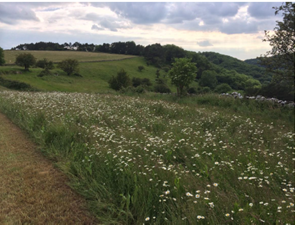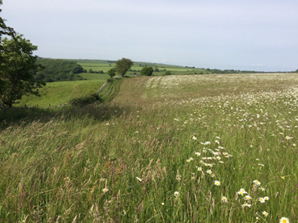- Home
- Knowledge library
- Managing herbal leys as another crop
Managing herbal leys as another crop
James Small recommends treating herbal leys as a crop to overcome the challenges of grazing it. James, a third generation farmer and partner in Small Brothers, farms 100 suckler cows and 1,200 breeding ewes in an extensive system, 900 ft above sea level on the Mendip Hills.
After growing herbal leys for several years, James now grows 50 acres of herbal leys in the ground, with 12 species in the mix including legumes, clovers, sainfoins, trefoil, chicory and plantain. These work well on the farm, which has light soils over limestone. This conversely makes the soil quite acidic.
Grazing herbal leys has come with some challenges; they tend to be selectively grazed by sheep, particularly in the first year, and wastage with chicory has been quite high if allowed to grow tall. James says, “The sheep targeted burnet, yarrow, sheeps parsley, ribgrass, lesser knapweed and common sorrel. ‘This is perhaps due to these plants being more delicate. We no longer grow these in the mix.”
“There is a perception that you if you leave these leys to flower they will be more productive in the following year” says James. This idea was trialled on a 6 m strip with the hope of maintaining more species, as shown in the photo on the left. The photo on right is the same strip in the following year. As you can see, the population density has dropped dramatically.


*Photos are from James' farm
To combat these issues, James recommends treating the herbal ley as a crop because they respond well to management and cutting, which actually produces a stronger ley in the first year. To avoid selective grazing, the crop is managed by taking 1–2 cuts of silage from it. In subsequent years, the ley is mob grazed. James says, “We have found if sheep are grazing the crop when it is tall and in flower there is quite a lot of wastage and they will selectively graze the species in the bottom. We manage this by topping it, still leaving it quite high for grazing”. James’ top tip is to move the sheep just before they look like they need moving in order to protect covers.
With limited crop protection products available, James has started to trial sowing different species at different times. In year one, a straight grass ley is sown in the spring and sprayed according to which weeds appear. He will then overseed with a herbal mix in the following autumn, a slightly more costly method of establishment, but he has seen more success with this method on their farm. The leys are at the optimum in the first 3–4 years, but can remain productive for 6–8 years, depending on species and cost-benefit. In his oldest leys (>8 years) the remaining species are grasses, clover, chicory and plantain.

